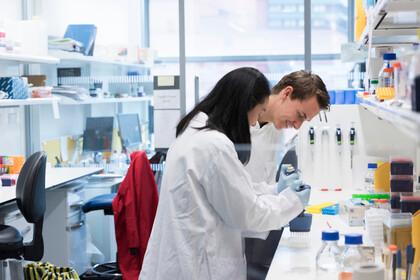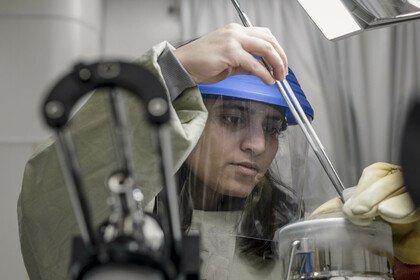
Wellcome Leap
Innovative funding to transform global human health. Fast.
Wellcome Leap is a US-based non-profit designed to make transformative improvements in human health at a speed and scale that are not usually possible. To achieve this, Wellcome Leap adopted a model of innovation that, historically, has generated some of the most influential breakthroughs of our time. In its first four years, Wellcome Leap launched 10 ambitious programmes and delivered evidence that could transform routine health checks of infants and support better starts in life for those who need it most.
Why we founded Wellcome Leap
We recognised that to tackle big, complex human health challenges quickly, we needed a radically different approach to standard funding models. Our financial and political independence gave us the ability to start an organisation designed to do this, with the freedom to take a different approach to the rest of Wellcome and wider health and life sciences funding systems.
Since 2020, we have invested $635mn in Wellcome Leap, creating an engine of ambitious, boundary-pushing discovery science and innovation. It is now the largest, most rapidly activatable research network in the world, meaning that the best minds can be brought together to work on health challenges at unprecedented speed. The Leap model is designed to make breakthroughs in five to ten years which would otherwise take 20.
How Wellcome Leap works
Wellcome Leap unites the values and perspective of Wellcome with the renowned model of innovation used at DARPA – the US Defence Advanced Research Projects Agency.
The DARPA model has a long track record of delivering significant innovations, such as the internet and GPS technology, extremely quickly. The taskforce responsible for the rapid development of the Covid-19 vaccines adopted aspects of the DARPA model to help get results at speed.
Vital elements of the Wellcome Leap model include:
- Precise, ambitious goals and timelines – breakthroughs require a sense of urgency and momentum, attempting the seemingly impossible in a seemingly impossible timeframe.
- Global collaboration and diversity of ideas – scientists, technologists and innovators from different countries, cultures and fields can solve problems together that they cannot solve alone.
- A non-linear approach – discovery and innovation happen at the same time, which means real-world solutions can be developed, tested and improved rapidly.
- Boldness – risk-taking and failure are seen as fundamental forces that propel programmes towards big leaps forward in health.
- No central research facility – participants work from their home organisations. With no need for regular travel or relocation, Leap can attract the best minds from across the world.
What has Wellcome Leap achieved so far?
In its first four years, Wellcome Leap has created the largest breakthrough network in the world, sped up contracting to get researchers funded and working in days or weeks rather than months, and launched 10 programmes with transformative potential.
The Human Organs, Physiology, and Engineering (HOPE) team is working to bioengineer human tissues and organs to enable more life-saving transplants and more effective testing of new drugs and treatments. Jointly funded with the Coalition for Epidemic Preparedness Innovations (CEPI), the RNA Readiness + Response (R3) team is aiming to develop a global network of biofoundries – facilities to produce biological material. Some of these materials can be used to treat life-threatening diseases such as cancer. The network will also be able to rapidly switch on the production of billions of vaccines during a global outbreak.
The First 1,000 Days (1kD) – seeking better starts in life for the children who need it most
In its first three years, Wellcome Leap’s 1kD programme has developed and demonstrated new tools for measuring and promoting healthy cognitive development in the first 1,000 days of a child’s life. This can have a big effect on a child’s future and their odds of dealing successfully with opportunities and obstacles they will face in life.
The programme’s scientific advances are being tested and scaled. These include nutritional supplements and pioneering playrooms that can support the development of vital skills and screen children to identify those most in need of additional help. The aim is to have the new tools available to caregivers by 2030 – providing more children with a strong and equitable start in life less than 10 years since the programme began.
Until now, it has been almost impossible to study some of the critical stages of brain and cognitive development that lead to the formation of executive function skills. Executive function skills govern a child’s ability to regulate emotions and switch attention, and are highly predictive of the life they will go on to lead.
Historically, the 20 percent of children who have underdeveloped executive function at age three go on to represent 80 percent of those who struggle to manage their health, require social assistance, or have encounters with crime.
The 1kD team has provided new scientific evidence of how the development of the brain and executive function can be affected by infant microbiomes – the community of organisms on and in our bodies, for example in our gut. 1kD is now developing nutritional supplements to support this. Alongside this, they have pioneered instrumented playrooms. These could provide a facility for universal screening of children to identify those most in need of support and promote the interactive child caregiver skills that are central to healthy brain development. These were tested over three culturally diverse populations. Work is underway to lay the foundation for the new tools to be available to caregivers by 2030.
Where is Wellcome Leap going next?
The Wellcome Leap funding approach means that not all goals will be achieved – failure is part of innovation. For us, Wellcome Leap will be successful if, by 2030, it has produced a small number of breakthroughs that:
- change existing practice, theories, concepts, standards or approaches used within a field or scientific area
- transform how a health problem is addressed
- open up new areas of research and allow new pressing scientific questions to be explored
- are delivered in 5-10 years rather than 20 years
- are picked up for further funding, development or commercialisation.


